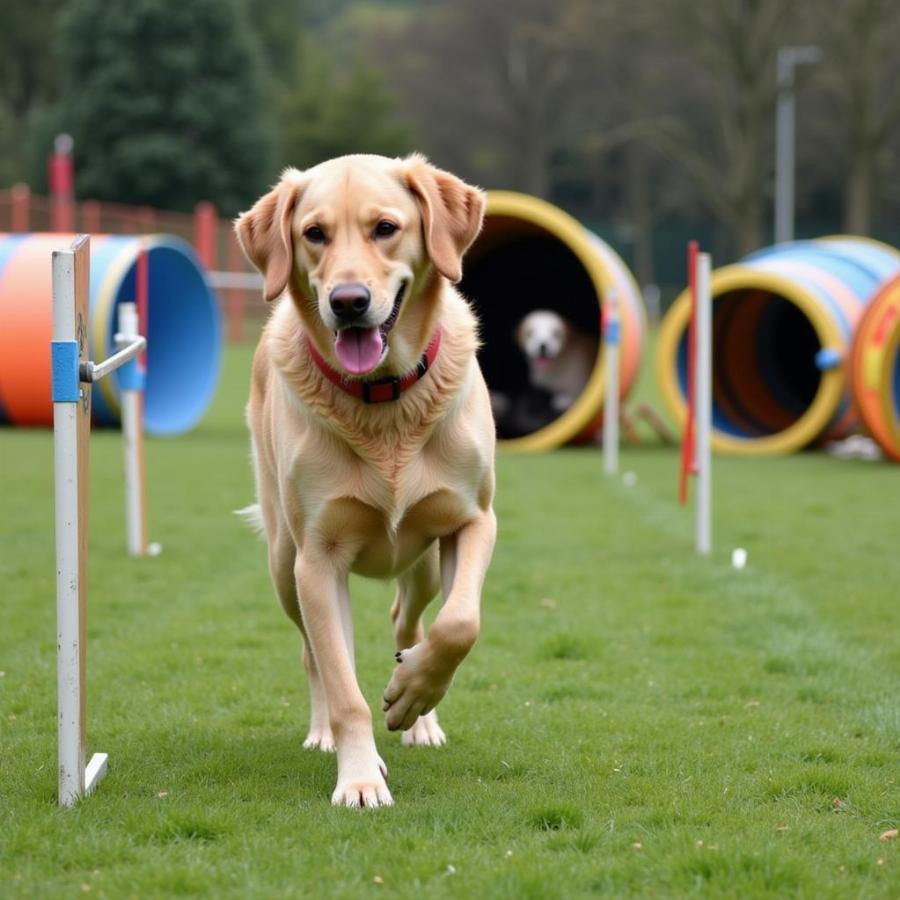Big dog bowling might sound like an unusual concept, but for some dog owners, it represents a unique way to bond with their large breed companions. However, before you picture your Great Dane knocking down pins, it’s important to understand what “big dog bowling” truly entails and whether it’s a suitable activity for your furry friend. This article will explore the different interpretations of this intriguing phrase and provide insights into safe and enriching activities for large breed dogs.
Decoding “Big Dog Bowling”
“Big Dog Bowling” can be interpreted in several ways. It could refer to:
- Figurative language: Sometimes, “big dog bowling” is used metaphorically to describe a situation where someone or something powerful is making a significant impact. This has no direct relation to dogs or bowling.
- Novelty dog toys: There are dog toys marketed as “bowling pins” designed for larger breeds. These toys allow dogs to “bowl” by pushing them over. This is a safe and fun way to engage your big dog indoors.
- Adapted bowling activities: While actual bowling alleys are rarely dog-friendly, some owners might create DIY versions in their backyards using lightweight, dog-safe objects.
- Misinterpretation: It’s possible that someone searching for “big dog bowling” is actually looking for information on activities suitable for large breeds, such as agility training or other dog sports.
Choosing the Right Activities for Your Big Dog
Large breed dogs have specific needs and considerations when it comes to exercise and enrichment. Factors such as breed, age, and individual temperament should be considered.
- Physical Exercise: Big dogs often require more vigorous exercise than smaller breeds. Activities like brisk walking, hiking, swimming, and fetch are great options.
- Mental Stimulation: Keeping your big dog mentally stimulated is crucial to prevent boredom and destructive behaviors. Puzzle toys, obedience training, and interactive games can provide mental enrichment.
 Chó lớn tham gia huấn luyện vận động
Chó lớn tham gia huấn luyện vận động
Ensuring Safety During Play
Safety is paramount when choosing activities for your large dog. Here are some key points to keep in mind:
- Appropriate toys: Select toys that are durable and appropriately sized for your dog to prevent choking hazards.
- Supervised play: Always supervise your dog during playtime, especially with new toys or activities.
- Gradual introduction: Introduce new activities gradually to avoid overwhelming your dog.
- Know your dog’s limits: Be mindful of your dog’s age, physical condition, and temperament. Avoid activities that could put undue stress on their joints or cause overheating.
“Remember,” says Dr. Emily Carter, a veterinarian specializing in canine sports medicine, “large breeds can be prone to certain joint issues, so it’s vital to choose activities that are safe and appropriate for their size and physical condition.”
Finding Alternative Activities
If “big dog bowling” in the literal sense isn’t feasible, there are plenty of other engaging activities for large breeds. Consider exploring:
- Dog parks: Provide opportunities for socialization and exercise under supervision.
- Agility training: A fun and challenging activity that enhances both physical and mental abilities.
- Canine freestyle: A combination of obedience and tricks performed to music.
- Dock diving: A thrilling water sport for dogs who love to swim and retrieve.
Conclusion
While “big dog bowling” might not be a standardized activity, it highlights the desire of owners to find creative ways to engage their large breed companions. By understanding your dog’s needs and prioritizing safety, you can choose activities that provide both physical exercise and mental stimulation, ensuring a happy and healthy life for your furry friend. Remember to consult with your veterinarian before starting any new exercise program.
FAQ
- Is actual bowling safe for dogs? No, bowling alleys are generally not dog-friendly due to noise levels and potential hazards.
- What are some good indoor activities for large dogs? Puzzle toys, hide-and-seek games, and indoor fetch with soft toys are good options.
- How much exercise does a large dog need? This varies by breed and individual, but most large dogs benefit from at least an hour of exercise daily.
- Are there dog sports specifically for large breeds? Yes, weight pulling and carting are popular options.
- How can I prevent my large dog from becoming bored? Provide plenty of mental stimulation through training, interactive toys, and regular walks.
- What are some signs of boredom in large dogs? Destructive behaviors, excessive barking, and restlessness can indicate boredom.
- Where can I find more information on large dog care? Consult your veterinarian or reputable online resources like the American Kennel Club (AKC).